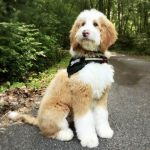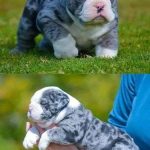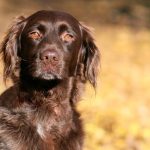
Do you want to have a Rottweiler? This breed has many good traits, in fact it’s an excellent guard dog, but it sheds heavily. If you are eager to get a dog of this breed but want a pet that sheds moderately, you might want to consider the Rottweiler Poodle mix.
In today’s post, get to know all the advantages of crossing the Rottweiler with a Poodle, aside from its decreased shedding level.
Origin
This designer breed is just one of the many Poodle mixes being bred today. Rottie-Poos are also called Rottles. It’s believed that they were first developed by German breeders during the 1980s, although there were claims that some pups may have been born earlier but were not documented. It did not come as a surprise that the crossbreed was first created in Germany, since the parent breeds both originated in that country.
History indicates that Rottweilers were descendants of the Roman cattle dogs. Later on, they were used by Germans for hunting bears. They also served as cattle dogs until the 19th century, when railways were set in and caused the Rottweiler’s popularity to decline. They became popular again during the First World War, when the Germans were looking for police dogs.
Like the Rottweilers, it is believed that Poodles were originally developed in Germany. Their name actually came from the world “pudelin” or splashing in water, which was the reason why they were developed in the first place. Poodles were traditionally bird dogs since they were created to hunt ducks. During the 1990s, they were also used to hunt fowls in the United States and Canada.
While Poodles came from Germany, they became immensely popular in France and they were even considered as the country’s national breed. They were always present in the show ring, especially during the late 19th century. Their popularity in the United States increased when they helped the military during the Second World War.
Appearance
The Rottie-Poo looks like a Rottweiler but it is heavily covered in fur. At first glance, you may not notice it’s a Rottweiler crossed with a Poodle until you look closer. Dogs of this breed have the Rottie’s iconic coloring, which is a combination of black and tan. However, it is possible to see Rottie-Poo pups sporting black, grey, or brown colors.
While Rottie-Poos only have a few available colors, they may come in a variety of coat textures. The coat can be harsh and rough like the one of the Rottieor corded and curly like that of the Poodle. Some pups may also appear to be a bit wavy, taking after the Rottweiler’s thick and silky coat. Regardless of their coat texture, expect the pup’s coat to be really dense.
Rottweiler-Poodles are medium-sized dogs but they have a sturdy built, thanks to the Rottweiler’s genes. They may take the Poodle’s size, which is around 13 to 18 inches for males and females and 20 to 34 kilograms but they can also be as big as the Rotties, which can grow up to 28 inches and as heavy as 48 to 60 kilograms.
A Rottie-Poo may have the same eyes as the Rottweilers, which are almond-shaped and have a dark browncolor. Their ears are also like those of the Rottweilers, triangular and pendant shape and lying forward close to their head. It’s rare to find Rottie-Poos sporting floppy ears like those of the Poodles.
Grooming
Unlike purebred Rotties that require the least amount of grooming, Rottie-Poos require more time for brushing and bathing. While Rottweilers are low-maintenance dogs, Poodles require high maintenance. This is due to the fact that they have a combination of dense and corded coats. Part of maintaining a healthy coat is making sure it is free from loose hairs.
When you have a Rottweiler Poodle cross, it helps to invest in a slicker brush which is specially created to get rid of mats and tangles, both common among Doodle dogs like Rottie-Poos. Slicker brushes are cheap and you can even find ones with a self-cleaning feature. A slicker brush with a slightly angled bristle is also gentler on your dog’s skin.
With their dense and curly coat, it’s a must to bathe Rottweiler Poodles regularly to lessen their shedding. The frequency of baths will depend on a pup’s lifestyle and activity levels. Rotties that are always outdoors can be bathed every three weeks while others can be bathed every two months, especially when a dog is always indoors. If you want to bathe your Rottie Poo, use lukewarm water and natural shampoo for dogs.
Personality
The Rottie-Poo pup is fairly easy to train so you can incorporate training in your his usual physical activities. As a smart dog, you can teach him basic obedience training even at an early age. Most dogs are being introduced to obedience training as early as eight weeks of age because dog trainers believe that the earlier, the better. Basic commands include staying in place, laying down, and sitting.
Exercise
Rottweiler Poodle dogs have high levels of energy, so it’s going to be difficult for them to adjust in confined spaces like small apartments. They do well in rural areas where there are large yards for them to run or play freely. For those who do not have enough space at home, it is important to take the dog outside for morning or evening walks. If you have an off-leash dog park in your locality, it will be a lot better because this allows your dog to socialize with other pets as he explores the surroundings.
Health
Rottweilers have a short lifespan. Their longevity range is around 8 to 11 years. Another benefit of crossing them with Poodles is the improved lifespan, since Poodles are healthier and known for their long lifespan. Many Poodles even make it up to 18 years or more, when well taken care of.
Aside from possibly inheriting the Poodle’s long life, Rottie Poos may benefit from having hybrid vigor. Also called heterosis, this outbreeding enhancement increases the biological quality of a hybrid offspring. There are different beliefs when it comes to hybrid vigor, but regardless of that, any dog will still be at risk of conditions commonly seen in the parent breeds. Here are some of the conditions this crossbreed may inherit from its parents:
Allergies – Rotties and Poodles are both prone to many kinds of allergies but the most common types among these dogs are skin allergies. Standard Poodles are especially at risk for skin allergies, which may be caused by several factors including their environment and hypersensitivity to certain foods. Skin allergy is characterized by itching, skin redness, and hotspots. The appropriate treatment for skin allergies will vary, depending on the root cause of the condition. If the culprit is food, a vet will need to do an elimination diet.
Bloating –in medical terms, bloating is called Gastric dilatation-volvulus(GDV). This occurs when the stomach’s elongated part twists more than 90 degrees. When there is a blockage in the esophagus, the content in your pet’s stomach will also be confined. This can lead to the expansion of the stomach due to the confined gas. Once this happens, your dog will feel pain and he will start showing distress by panting or being restless. To prevent bloating, you should wait at least an hour after feeding your dog for exercise. It’s recommended to divide the number of feedings to three or four times a day rather than giving one large meal to dogs.
Hip Dysplasia – large and giant breeds are prone to hip dysplasia, a hereditary condition seen in a number of breeds. While the exact cause is not yet identified, vets can confirm that certain factors can magnify hip dysplasia. This includes strenuous activities after a meal, excessive growth rate, and poor nutrition. To avoid hip dysplasia, try to limit your pet’s exercise and avoid intense physical activities.
Hypothyroidism – this condition can be inherited but more often than not, it happens when a dog suffers from thyroiditis, an autoimmune destruction happening on the thyroid gland. It’s rare but it can also be caused by thyroid gland cancer. A dog diagnosed with hypothyroidism should be put on oral replacement hormone two times a day for the rest of its life. A vet will also recommend tweaking the dog’s diet by adding more iodine. This mineral is essential for thyroid health and can be derived from shellfish and kelp.
Feeding
One of the issues with Rottweilers is obesity, which can lead to many health problems like joint problems and hip dysplasia. You will know a dog is already obese if you can no longer feel his ribs when touching his stomach. Hence, it is important to feed your Rottie-Poo the right quantity of dog food.
Cost
Rottie-Poo pups are sold at prices between $600 to $1,300. It’s rare to find these dogs in kennels so you really need to find Rottie-Poos breeders. Make sure you are working with reputable breeders and secure health testing and certificate from your potential breeders.
Conclusion
A Rottie-Poo has the best of both worlds. It has the Rottweiler’s excellent guarding abilities and the Standard Poodle’s hypoallergenic nature. It’s ideal for families who want a unique Doodle pet with calm temperament.





















